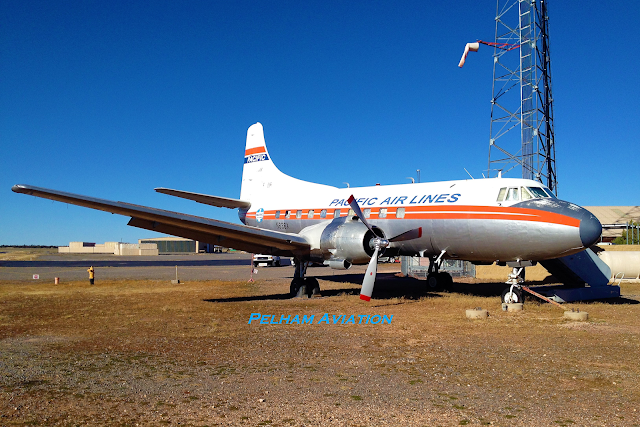ThrowbackThursday Planes of Fame Air Museum Photos
Throwback to Planes of Fame Air Museum Arizona
October 22, 2020
Michael Gutta
For a little Throwback Thursday I
decided to revisit a few photos I took while visiting the Planes of Fame Air
Museum in Valle, Arizona back on November 5, 2013. This aircraft museum is
located at the Valle Airport 30 miles south of Grand Canyon Village. During a
family vacation touring several spots in Arizona we made a quick stop on the drive
to Grand Canyon. There were and still are many aircraft in various states from
flyable and restored to those that are neglected under the Arizona sun. Overall,
it was a great way to spend an hour of time and $10 to see a variety of
aircraft from the past. Below, I’ve highlighted four photos from this experience
with a few details on each aircraft type.
 |
| North American T-28B "Trojan" trainer aircraft built in 1954 at the Planes of Fame Air Museum (Michael Gutta). |
With a first flight in 1949, a total of 1,948 aircraft were built between 1950 and 1957 by North American designated as the T-28. The T-28 was designed to replace the T-6 Texan and served as the primary trainer aircraft for the US Air Force, Navy, Coast Guard, and Marine Corps from the 1960’s until 1984. The “Trojan” also saw service with a variety of countries around the world. This particular “B” version was the navy version with a 1,425hp Wright radial engine capable of almost 300 knots at 10,000 feet.
 |
| Stinson L-5 "Sentinel" multipurpose liaison aircraft built in 1945 at the Planes of Fame Air Museum (Michael Gutta). |
The “Sentinel” was produced from 1942 to 1945 and was used by all branches of the US military and the British RAF during WWII. Over 3,500 aircraft were produced, making it the second most produced light aircraft after the Piper Cub. The “Sentinel” was typically fitted with a Lycoming O-435-1 185hp horizontally opposed piston engine and was capable of about 115 knots with a typical crew of 2.
 |
| Martin 4-0-4 airliner painted with Pacific Air Lines livery and registration N636X at the Planes of Fame Air Museum (Michael Gutta). |
This Martin 4-0-4 aircraft was built in 1952 and could accommodate 40 passengers. The Martin 4-0-4 had a pressurized fuselage, retractable tricycle landing gear, and two Pratt & Whitney radial engines producing 2,400hp each. A total of only 103 aircraft were produced from 1951 to 1953 for Eastern Air Lines, Trans World Airlines, and the US Coast Guard. These were later transferred and operated by a number of smaller carriers throughout the US including Pacific Air Lines. The Martin 4-0-4 could cruise at 240 knots at 18,000 feet with a range of 940 nautical miles.
 |
| Lockheed T-33A "Shooting Star" built in 1953 at the Planes of Fame Air Museum (Michael Gutta). |
The T-33 jet trainer is a two-seater with extensive global use. Over 5,600 aircraft were produced, and many are on display with several still in flying condition. With a first flight in 1948, this venerable aircraft was finally retired by the Bolivian Air Force in just 2017. Notably, Boeing uses the T-33 as a chase and photography aircraft. The Boeing T-33 was flown as the chase plane for the maiden flight of the 787, 737 MAX 7, and 777-9 aircraft. The “shooting star” is powered by a single Allison J33-A-35 centrifugal turbojet engine producing up to 5,400 foot-pounds of thrust augmented by water injection. This aircraft is subsonic and capable of up to 520 knots at sea level with a range of 1,100 nautical miles.
Let me know your thoughts on this
blog post and potential future topics involving anything aviation related. The
Planes of Fame Air Museum currently has two locations: Chino, California and
Valle, Arizona. The location in Valle, Arizona is currently closed due to
COVID-19. More information about the Planes of Fame Air Museum can be found
below:



Comments
Post a Comment